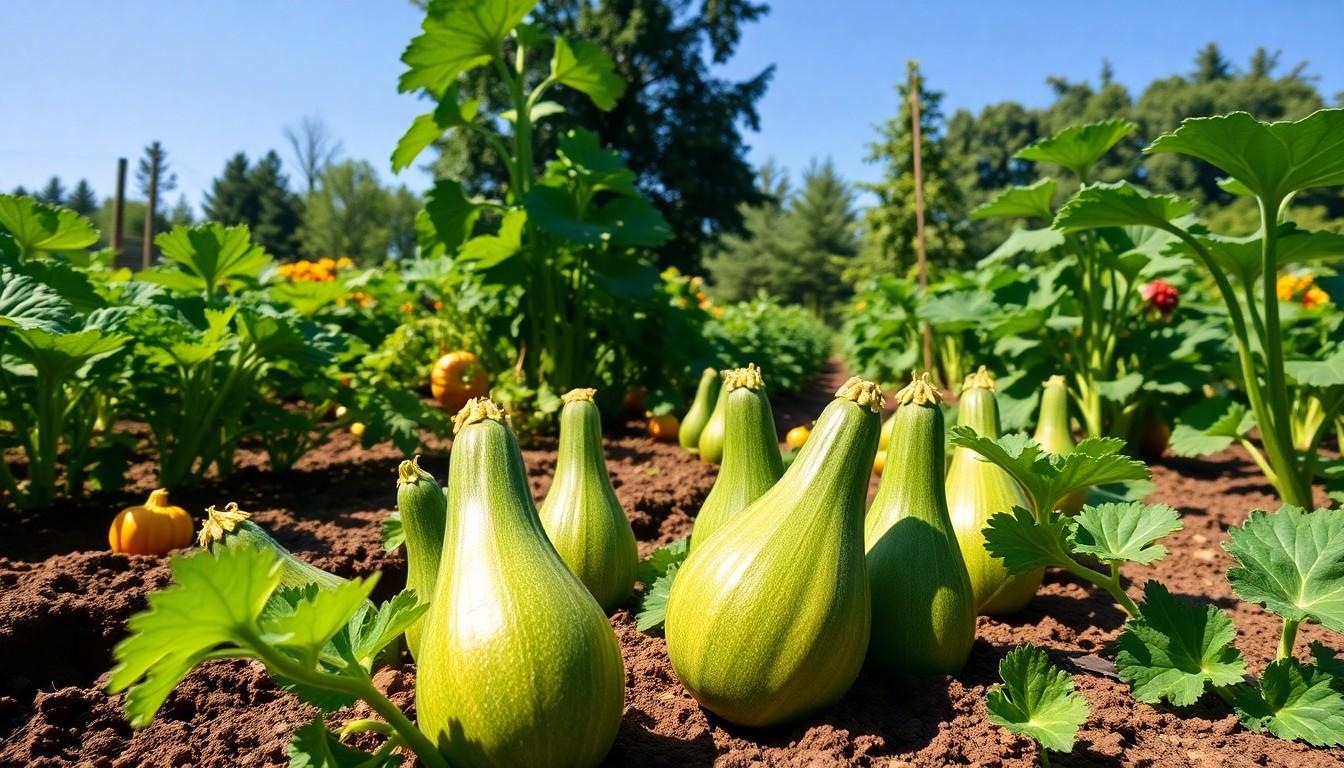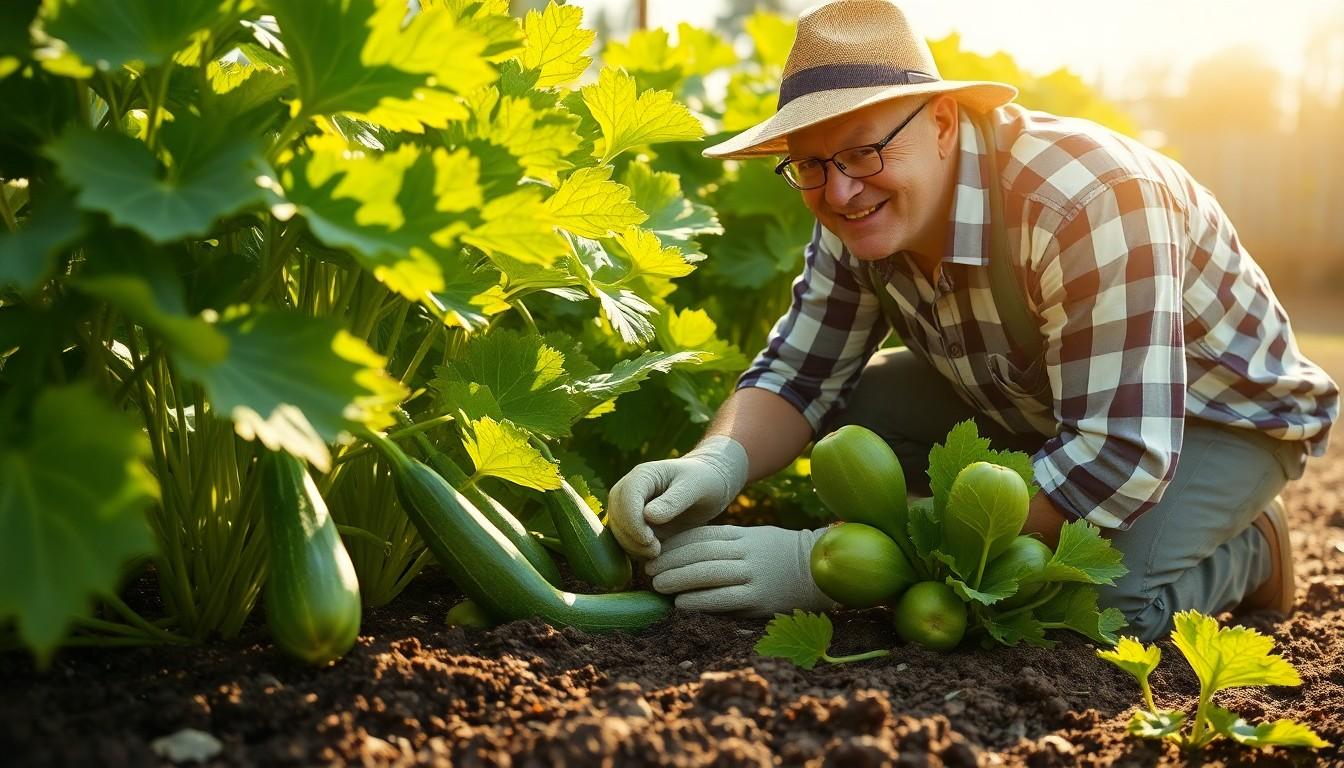If you think zucchini is just a bland vegetable, think again! This versatile powerhouse can transform any meal from drab to fab. But before those vibrant green beauties grace your kitchen, they need a little TLC in the garden. Zucchini plant care isn’t just about watering and hoping for the best; it’s like giving your plants a spa day, minus the cucumber slices on their eyes.
Overview of Zucchini Plant Care
Zucchini plants thrive with attention to several key care aspects. Soil preparation plays a crucial role; well-drained soil enriched with organic matter supports healthy growth. Maintaining a pH level between 6.0 and 7.5 encourages vigor in zucchini plants.
Watering requires consistent efforts; zucchini plants need approximately 1 to 2 inches of water weekly. It’s best to water deeply rather than frequently, promoting strong root development. Mulching around plants helps retain moisture and suppress weeds.
Fertilizing enhances plant nutrition; a balanced fertilizer with equal parts nitrogen, phosphorus, and potassium delivers essential nutrients. Applying fertilizer every four to six weeks during the growing season encourages robust growth and fruit production.
Temperature influences zucchini health; optimal growing conditions occur when daytime temperatures range from 70°F to 95°F. Planting zucchini after the last frost promotes successful germination.
Pest management is vital; common pests like squash bugs and cucumber beetles may affect zucchini plants. Regularly inspecting plants helps identify and address pest problems early. Handpicking pests and using insecticidal soap can prevent damage.
Disease prevention also matters; proper spacing between plants improves air circulation, reducing the likelihood of fungal infections. Rotating zucchini and other cucurbits with non-related crops reduces the risk of soil-borne diseases.
Harvesting zucchini should occur when fruits reach 6 to 8 inches long. Regular picking encourages continuous production, preventing over-mature fruits that can affect plant performance.
Adopting these care practices ensures productive zucchini plants yield abundant crops, enhancing their presence in the garden.
Essential Growing Conditions

Zucchini plants thrive under specific conditions that promote healthy growth and maximize yield.
Soil Requirements
Well-drained, organic-rich soil significantly benefits zucchini plants. Nutrient-dense soil supports strong root systems and healthy plant development. A pH level between 6.0 and 7.5 is optimal for nutrient absorption, ensuring plants receive necessary elements. Amending soil with compost enhances its fertility and structure. Regular testing of soil conditions helps maintain ideal growing conditions.
Sunlight Needs
Zucchini plants flourish in full sun, requiring at least six to eight hours of direct sunlight daily. Bright light promotes robust growth and encourages fruit production. Insufficient sunlight can lead to spindly plants and poor yields. Strategic placement in a garden or vegetable patch ensures plants receive adequate exposure. Consider positioning zucchini away from taller plants that may cast shade.
Temperature Preferences
Optimal temperatures for zucchini range from 70°F to 95°F. Warm weather supports germination and overall plant vigor. Cold temperatures can stunt growth and increase susceptibility to diseases. Planting occurs after the last frost to provide the best chance of survival. Monitoring nighttime lows helps avoid potential damage during cooler months.
Watering Techniques
Watering techniques are essential for healthy zucchini plant growth. Consistent and efficient moisture management contributes significantly to their overall vitality.
Frequency of Watering
Water every week with a focus on delivering 1 to 2 inches of water. Weekly watering promotes deep root growth, which enhances drought resistance. If rainfall is abundant, check soil moisture to adjust the schedule accordingly. Most zucchini plants thrive on deep watering, allowing the roots to access the moisture they need. During hot weather, increase watering frequency to twice a week while ensuring water penetrates the soil deeply. Use a soaker hose or drip irrigation for efficient moisture delivery, minimizing evaporation.
Signs of Overwatering and Underwatering
Overwatering can manifest as yellowing leaves, wilting, or root rot. Plants may exhibit water stress when overwatered, taking on a soggy appearance. Underwatering shows different signs such as drooping leaves and dry soil. Roots may become stunted and unable to take up nutrients effectively. Observing the leaves and soil condition allows for timely adjustments to watering practices. Maintaining proper moisture balance encourages vigorous growth and maximizes zucchini yield. Regular monitoring prevents issues associated with both overwatering and underwatering.
Fertilization Strategies
Effective fertilization strategies play a crucial role in nurturing zucchini plants. Employing the right types of fertilizers and application methods ensures robust growth and optimal yield.
Types of Fertilizers
Organic fertilizers, such as compost and aged manure, provide a slow release of nutrients. They improve soil structure and enhance microbial activity. Synthetic fertilizers containing balanced ratios of nitrogen, phosphorus, and potassium also benefit zucchini plants, promoting lush foliage and abundant fruit. Specific products like 10-10-10 and 5-10-10 can deliver targeted nutrition. Seasonal amendments with fish emulsion or bone meal further enhance fertility, providing essential elements for plant health. Soil testing helps determine nutrient deficiencies, allowing for tailored fertilization approaches.
Application Methods
Incorporating fertilizers into the soil during planting promotes early growth. Side dressing with granular fertilizers around the base of plants every four to six weeks boosts nutrient levels throughout the growing season. Liquid fertilizers offer immediate absorption, making them ideal for quick nutrient replenishment. Using a dilution method ensures even distribution without overwhelming the plants. Drip irrigation systems can efficiently deliver nutrients directly to the roots, minimizing waste and maximizing impact. Timing applications during the early morning or late afternoon reduces evaporation, enhancing nutrient uptake and effectiveness.
Common Pests and Diseases
Zucchini plants face threats from various pests and diseases, making awareness and prevention essential for healthy growth.
Pest Prevention
To safeguard zucchini plants, regular inspection for pests is vital. Squash bugs, cucumber beetles, and aphids often infest these plants. Employing row covers before flowering protects young plants. Encouraging beneficial insects like ladybugs helps control harmful populations naturally. Crop rotation reduces the chance of pest buildup in the soil. Maintaining proper spacing between plants improves air circulation, deterring pests. Using organic insecticides can further manage infestations effectively.
Disease Management
Managing diseases ensures zucchini plants thrive throughout the growing season. Fungal diseases like powdery mildew and downy mildew often affect zucchini. Providing proper spacing and airflow minimizes humidity around plants. Resistant varieties can significantly reduce susceptibility to common diseases. Implementing crop rotation also disrupts disease cycles. Regularly inspecting for symptoms such as yellowing leaves allows for prompt treatment. Removing infected plant debris at the end of the season contributes to long-term disease prevention.
Conclusion
Caring for zucchini plants is essential for a bountiful harvest. By providing the right conditions—nutrient-rich soil, consistent watering, and ample sunlight—gardeners can cultivate thriving plants. Regular monitoring for pests and diseases further ensures that zucchini remains healthy throughout the growing season.
Implementing these practices not only enhances the plant’s growth but also maximizes fruit yield. With proper attention and care, zucchini can transform from a simple garden vegetable into a flavorful staple in any kitchen. Embracing these care techniques will lead to rewarding results and a vibrant garden.

